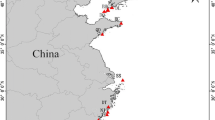Abstract
The genetic diversity and population structure of Cyclina sinensis were assessed using amplified fragment length polymorphism (AFLP). Three hundred and fifty-four AFLP loci were analyzed in 160 individuals collected from Lvshun, Lianyungang, Yueqing and Dongxing of coastal China. High levels of genetic diversity were detected, where the percentage of polymorphic loci and average expected heterozygosity ranged 88.4–98.9% and 0.304–0.365, respectively. Analysis of molecular variance showed that variation among populations (24.4%) was highly significant (P<0.001). Accordingly, the global fixation index (θ B) averaged over lici was high (0.205). The large genetic differences among populations indicate restricted gene flow, congruent with limited dispersal capability of C. sinensis. The unweighted pair group method with arithmetic mean (UPGMA) tree topology constructed on the basis of Nei’s genetic distances between populations showed a clear separation of the northern two populations from the southern two populations, suggesting that gene flow between the northern and southern regions is extremely low. This finding is additionally supported by the separate clustering of the four populations in the results of principal coordinate analysis. The useful information obtained in this study will offer insights to fine-tune conservation and fishery management measures in the future.
Similar content being viewed by others
References
Sun T, Tian J, Li Y, Guo J, Gou Z, Yin Z. Artificial seeds production of Cyclina sinensis in earth ponds. Shandong Fish 2003; 20: 17 (in Chinese).
Yang X, Ji H, Yu Y, Guan J, Sun Y. Preliminary study of the juvenile nursery of Cyclina sinensis. J. Shanghai Fish. Univ. 2004; 13: 213–217 (in Chinese).
Yu Y, Wang H, Lu P, Huang Z, Wu J. Preliminary study on growth of Cyclina sinensis. Mar. Sci. 1996; 1: 10–14 (in Chinese).
Sun G, Wan X, Liu P, Xu P, Gao C. Preliminary analysis of mass mortality of Cyclina sinensis in Tongzhou region. J. Aquacult. 2004; 25: 26–27 (in Chinese).
Yu Y, Gu R, Yang X. Survival condition and nutrition of Cyclina sinensis. Mar. Sci. 2005; 29: 10–14 (in Chinese).
Yao Z, Zhou K, Lai Q, Wang H, Xia L. Analysis of genetic variations of five geographical populations in Cyclina sinensis (Gmelin) of China by RAPD. Mar. Fish. 2005; 27: 102–108 (in Chinese).
Pan B, Song L, Bu W, Sun J. Studies on genetic diversity and differentiation between two allopatric populations of Cyclina sinensis. Acta Hydrobiol. Sinica 2005; 29: 372–378 (in Chinese).
Vos P, Hogers R, Bleeker M, Reijans M, van de Lee T, Hornes M, Frijters A, Pot J, Peleman J, Kuiper M. AFLP: a new technique for DNA fingerprinting. Nucleic Acids Res. 1995; 23: 4407–4414.
Mueller UG, Wolfenbarger LL. AFLP genotyping and finger-printing. Trends Ecol. Evol. 1999; 14: 389–394.
Nybom H. Comparison of different nuclear DNA markers for estimating: intraspecific genetic diversity in plants. Mol. Ecol. 2004; 13: 1143–1155.
Li Q, Park C, Kijima A. Isolation and characterization of microsatellite loci in the Pacific abalone, Haliotis discus hannai. J. Shellfish Res. 2002; 21: 811–815.
Zhivotovsky LA. Estimating population structure in diploids with multilocus dominant DNA markers. Mol. Ecol. 1999; 8: 907–913.
Vekemans X, Beauwens T, Lemaire M, Roldán-Ruiz I. Data from amplified fragment length polymorphism (AFLP) markers show indication of size homoplasy and of a relationship between degree of homoplasy and fragment size. Mol. Ecol. 2002; 11: 139–151.
Holsinger KE, Lewis PO, Dey DK. A Bayesian approach to inferring population structure from dominant markers. Mol. Ecol. 2002; 11: 1157–1164.
Excoffier L, Laval G, Schneider S. Arlequin, ver. 3.0. an integrated software package for population genetics data analysis. Evol. Bioinform. Online 2005; 1: 47–50.
Nei M. Estimation of average heterozygosity and genetic distance from a small number of individuals. Genetics 1978; 89: 583–590.
Felsenstein J Phylip. Version 3.65. Department of Genetics, University of Washington, Seattle, WA. 2005.
Peakall R, Smouse PE. GENALEX 6: genetic analysis in Excel. Population genetic software for teaching and research. Mol. Ecol. Notes 2006; 6: 288–295.
Hedrick PW. Genetics of Populations. Jones and Bartlett, Boston, MA. 1985.
Frankham R. Relationship of genetic variation to population size in wildlife. Conserv. Biol. 1996; 10: 1500–1508.
Wang R, Wang Z, Zhang J. Culture of Marine Mollusks. China Ocean University Press, Oingdao. 1993 (in Chinese).
ECCBR (Edit Committee of China Bay Records). China Bay Records. Ocean Press, Beijing. 1993 (in Chinese).
Kimura M, Weiss G. The stepping stone model of population structure and the decrease of genetic correlation with distance. Genetics 1964; 49: 561–576.
Author information
Authors and Affiliations
Corresponding author
Rights and permissions
About this article
Cite this article
Zhao, Y., Li, Q., Kong, L. et al. Genetic diversity and divergence among clam Cyclina sinensis populations assessed using amplified fragment length polymorphism. Fish Sci 73, 1338–1343 (2007). https://doi.org/10.1111/j.1444-2906.2007.01473.x
Received:
Accepted:
Issue Date:
DOI: https://doi.org/10.1111/j.1444-2906.2007.01473.x



